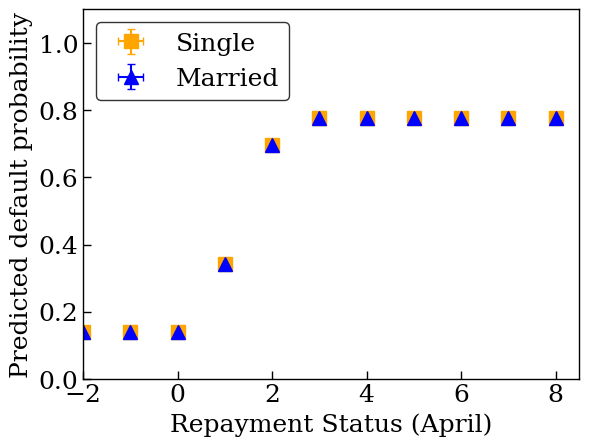 View on TensorFlow.org View on TensorFlow.org
|
 Run in Google Colab Run in Google Colab
|
 View source on GitHub View source on GitHub
|
 Download notebook Download notebook
|
Overview
This tutorial demonstrates how the TensorFlow Lattice (TFL) library can be used to train models that behave responsibly, and do not violate certain assumptions that are ethical or fair. In particular, we will focus on using monotonicity constraints to avoid unfair penalization of certain attributes. This tutorial includes demonstrations of the experiments from the paper Deontological Ethics By Monotonicity Shape Constraints by Serena Wang and Maya Gupta, published at AISTATS 2020.
We will use TFL premade models on public datasets, but note that everything in this tutorial can also be done with models constructed from TFL Keras layers.
Before proceeding, make sure your runtime has all required packages installed (as imported in the code cells below).
Setup
Installing TF Lattice package:
pip install -U tensorflow tf-keras tensorflow-lattice seaborn pydot graphvizpip install -U tensorflow_decision_forests
Importing required packages:
import tensorflow as tf
import tensorflow_lattice as tfl
import tensorflow_decision_forests as tfdf
import logging
import matplotlib.pyplot as plt
import numpy as np
import os
import pandas as pd
import seaborn as sns
from sklearn.model_selection import train_test_split
import sys
import tempfile
logging.disable(sys.maxsize)
2024-12-15 12:24:39.272389: E external/local_xla/xla/stream_executor/cuda/cuda_fft.cc:477] Unable to register cuFFT factory: Attempting to register factory for plugin cuFFT when one has already been registered WARNING: All log messages before absl::InitializeLog() is called are written to STDERR E0000 00:00:1734265479.296062 73126 cuda_dnn.cc:8310] Unable to register cuDNN factory: Attempting to register factory for plugin cuDNN when one has already been registered E0000 00:00:1734265479.303333 73126 cuda_blas.cc:1418] Unable to register cuBLAS factory: Attempting to register factory for plugin cuBLAS when one has already been registered
# Use Keras 2.
version_fn = getattr(tf.keras, "version", None)
if version_fn and version_fn().startswith("3."):
import tf_keras as keras
else:
keras = tf.keras
Default values used in this tutorial:
# Default number of training epochs, batch sizes and learning rate.
NUM_EPOCHS = 256
BATCH_SIZE = 256
LEARNING_RATES = 0.01
# Directory containing dataset files.
DATA_DIR = 'https://raw.githubusercontent.com/serenalwang/shape_constraints_for_ethics/master'
Case study #1: Law school admissions
In the first part of this tutorial, we will consider a case study using the Law School Admissions dataset from the Law School Admissions Council (LSAC). We will train a classifier to predict whether or not a student will pass the bar using two features: the student's LSAT score and undergraduate GPA.
Suppose that the classifier’s score was used to guide law school admissions or scholarships. According to merit-based social norms, we would expect that students with higher GPA and higher LSAT score should receive a higher score from the classifier. However, we will observe that it is easy for models to violate these intuitive norms, and sometimes penalize people for having a higher GPA or LSAT score.
To address this unfair penalization problem, we can impose monotonicity constraints so that a model never penalizes higher GPA or higher LSAT score, all else equal. In this tutorial, we will show how to impose those monotonicity constraints using TFL.
Load Law School Data
# Load data file.
law_file_name = 'lsac.csv'
law_file_path = os.path.join(DATA_DIR, law_file_name)
raw_law_df = pd.read_csv(law_file_path, delimiter=',')
Preprocess dataset:
# Define label column name.
LAW_LABEL = 'pass_bar'
def preprocess_law_data(input_df):
# Drop rows with where the label or features of interest are missing.
output_df = input_df[~input_df[LAW_LABEL].isna() & ~input_df['ugpa'].isna() &
(input_df['ugpa'] > 0) & ~input_df['lsat'].isna()]
return output_df
law_df = preprocess_law_data(raw_law_df)
Split data into train/validation/test sets
def split_dataset(input_df, random_state=888):
"""Splits an input dataset into train, val, and test sets."""
train_df, test_val_df = train_test_split(
input_df, test_size=0.3, random_state=random_state
)
val_df, test_df = train_test_split(
test_val_df, test_size=0.66, random_state=random_state
)
return train_df, val_df, test_df
dataframes = {}
datasets = {}
(dataframes['law_train'], dataframes['law_val'], dataframes['law_test']) = (
split_dataset(law_df)
)
for df_name, df in dataframes.items():
datasets[df_name] = tf.data.Dataset.from_tensor_slices(
((df[['ugpa']], df[['lsat']]), df[['pass_bar']])
).batch(BATCH_SIZE)
2024-12-15 12:24:43.408373: E external/local_xla/xla/stream_executor/cuda/cuda_driver.cc:152] failed call to cuInit: INTERNAL: CUDA error: Failed call to cuInit: CUDA_ERROR_NO_DEVICE: no CUDA-capable device is detected
Visualize data distribution
First we will visualize the distribution of the data. We will plot the GPA and LSAT scores for all students that passed the bar and also for all students that did not pass the bar.
def plot_dataset_contour(input_df, title):
plt.rcParams['font.family'] = ['serif']
g = sns.jointplot(
x='ugpa',
y='lsat',
data=input_df,
kind='kde',
xlim=[1.4, 4],
ylim=[0, 50])
g.plot_joint(plt.scatter, c='b', s=10, linewidth=1, marker='+')
g.ax_joint.collections[0].set_alpha(0)
g.set_axis_labels('Undergraduate GPA', 'LSAT score', fontsize=14)
g.fig.suptitle(title, fontsize=14)
# Adust plot so that the title fits.
plt.subplots_adjust(top=0.9)
plt.show()
law_df_pos = law_df[law_df[LAW_LABEL] == 1]
plot_dataset_contour(
law_df_pos, title='Distribution of students that passed the bar')
law_df_neg = law_df[law_df[LAW_LABEL] == 0]
plot_dataset_contour(
law_df_neg, title='Distribution of students that failed the bar')

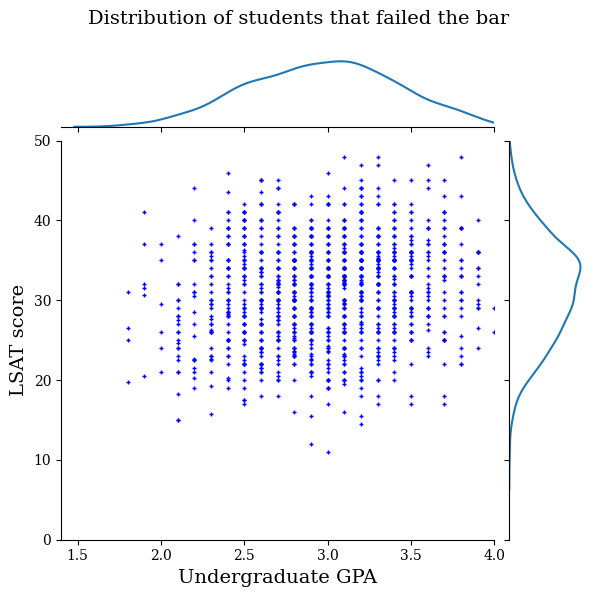
Train calibrated lattice model to predict bar exam passage
Next, we will train a calibrated lattice model from TFL to predict whether or not a student will pass the bar. The two input features will be LSAT score and undergraduate GPA, and the training label will be whether the student passed the bar.
We will first train a calibrated lattice model without any constraints. Then, we will train a calibrated lattice model with monotonicity constraints and observe the difference in the model output and accuracy.
Helper functions for visualization of trained model outputs
def plot_model_contour(model, from_logits=False, num_keypoints=20):
x = np.linspace(min(law_df['ugpa']), max(law_df['ugpa']), num_keypoints)
y = np.linspace(min(law_df['lsat']), max(law_df['lsat']), num_keypoints)
x_grid, y_grid = np.meshgrid(x, y)
positions = np.vstack([x_grid.ravel(), y_grid.ravel()])
plot_df = pd.DataFrame(positions.T, columns=['ugpa', 'lsat'])
plot_df[LAW_LABEL] = np.ones(len(plot_df))
predictions = model.predict((plot_df[['ugpa']], plot_df[['lsat']]))
if from_logits:
predictions = tf.math.sigmoid(predictions)
grid_predictions = np.reshape(predictions, x_grid.shape)
plt.rcParams['font.family'] = ['serif']
plt.contour(
x_grid,
y_grid,
grid_predictions,
colors=('k',),
levels=np.linspace(0, 1, 11),
)
plt.contourf(
x_grid,
y_grid,
grid_predictions,
cmap=plt.cm.bone,
levels=np.linspace(0, 1, 11),
)
plt.xticks(fontsize=20)
plt.yticks(fontsize=20)
cbar = plt.colorbar()
cbar.ax.set_ylabel('Model score', fontsize=20)
cbar.ax.tick_params(labelsize=20)
plt.xlabel('Undergraduate GPA', fontsize=20)
plt.ylabel('LSAT score', fontsize=20)
Train unconstrained (non-monotonic) calibrated lattice model
We create a TFL premade model using a 'CalibratedLatticeConfig. This model is a calibrated lattice model with an output calibration.
model_config = tfl.configs.CalibratedLatticeConfig(
feature_configs=[
tfl.configs.FeatureConfig(
name='ugpa',
lattice_size=3,
pwl_calibration_num_keypoints=16,
monotonicity=0,
pwl_calibration_always_monotonic=False,
),
tfl.configs.FeatureConfig(
name='lsat',
lattice_size=3,
pwl_calibration_num_keypoints=16,
monotonicity=0,
pwl_calibration_always_monotonic=False,
),
],
output_calibration=True,
output_initialization=np.linspace(-2, 2, num=8),
)
We calculate and populate feature quantiles in the feature configs using the premade_lib API.
feature_keypoints = tfl.premade_lib.compute_feature_keypoints(
feature_configs=model_config.feature_configs,
features=dataframes['law_train'][['ugpa', 'lsat', 'pass_bar']],
)
tfl.premade_lib.set_feature_keypoints(
feature_configs=model_config.feature_configs,
feature_keypoints=feature_keypoints,
add_missing_feature_configs=False,
)
nomon_lattice_model = tfl.premade.CalibratedLattice(model_config=model_config)
keras.utils.plot_model(
nomon_lattice_model, expand_nested=True, show_layer_names=False, rankdir="LR"
)

nomon_lattice_model.compile(
loss=keras.losses.BinaryCrossentropy(from_logits=True),
metrics=[
keras.metrics.BinaryAccuracy(name='accuracy'),
],
optimizer=keras.optimizers.Adam(LEARNING_RATES),
)
nomon_lattice_model.fit(datasets['law_train'], epochs=NUM_EPOCHS, verbose=0)
train_acc = nomon_lattice_model.evaluate(datasets['law_train'])[1]
val_acc = nomon_lattice_model.evaluate(datasets['law_val'])[1]
test_acc = nomon_lattice_model.evaluate(datasets['law_test'])[1]
print(
'accuracies for train: %f, val: %f, test: %f'
% (train_acc, val_acc, test_acc)
)
63/63 [==============================] - 0s 1ms/step - loss: 0.1727 - accuracy: 0.9460 10/10 [==============================] - 0s 1ms/step - loss: 0.1877 - accuracy: 0.9390 18/18 [==============================] - 0s 1ms/step - loss: 0.1672 - accuracy: 0.9480 accuracies for train: 0.945995, val: 0.939003, test: 0.948020
plot_model_contour(nomon_lattice_model, from_logits=True)
13/13 [==============================] - 0s 1ms/step
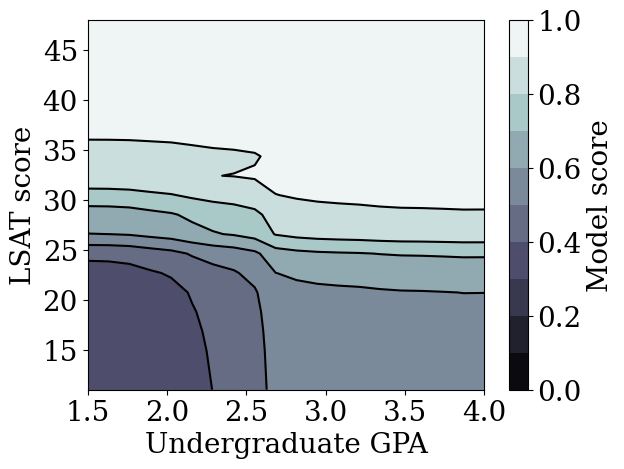
Train monotonic calibrated lattice model
We can get a monotonic model by setting the monotonicity constraints in feature configs.
model_config.feature_configs[0].monotonicity = 1
model_config.feature_configs[1].monotonicity = 1
mon_lattice_model = tfl.premade.CalibratedLattice(model_config=model_config)
mon_lattice_model.compile(
loss=keras.losses.BinaryCrossentropy(from_logits=True),
metrics=[
keras.metrics.BinaryAccuracy(name='accuracy'),
],
optimizer=keras.optimizers.Adam(LEARNING_RATES),
)
mon_lattice_model.fit(datasets['law_train'], epochs=NUM_EPOCHS, verbose=0)
train_acc = mon_lattice_model.evaluate(datasets['law_train'])[1]
val_acc = mon_lattice_model.evaluate(datasets['law_val'])[1]
test_acc = mon_lattice_model.evaluate(datasets['law_test'])[1]
print(
'accuracies for train: %f, val: %f, test: %f'
% (train_acc, val_acc, test_acc)
)
63/63 [==============================] - 0s 1ms/step - loss: 0.1712 - accuracy: 0.9463 10/10 [==============================] - 0s 1ms/step - loss: 0.1869 - accuracy: 0.9403 18/18 [==============================] - 0s 1ms/step - loss: 0.1654 - accuracy: 0.9487 accuracies for train: 0.946308, val: 0.940292, test: 0.948684
plot_model_contour(mon_lattice_model, from_logits=True)
13/13 [==============================] - 0s 1ms/step
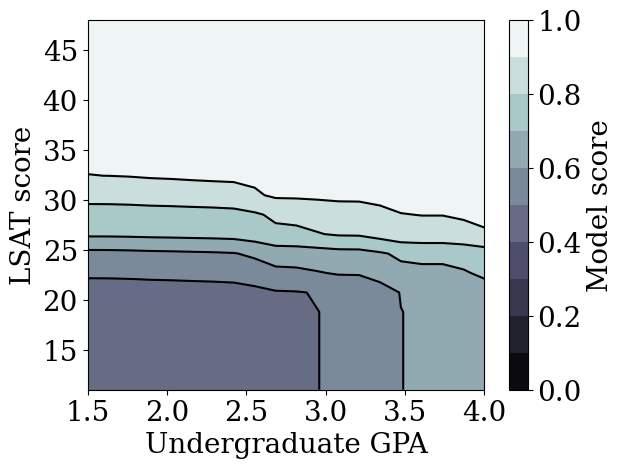
We demonstrated that TFL calibrated lattice models could be trained to be monotonic in both LSAT score and GPA without too big of a sacrifice in accuracy.
Train other unconstrained models
How does the calibrated lattice model compare to other types of models, like deep neural networks (DNNs) or gradient boosted trees (GBTs)? Do DNNs and GBTs appear to have reasonably fair outputs? To address this question, we will next train an unconstrained DNN and GBT. In fact, we will observe that the DNN and GBT both easily violate monotonicity in LSAT score and undergraduate GPA.
Train an unconstrained Deep Neural Network (DNN) model
The architecture was previously optimized to achieve high validation accuracy.
keras.utils.set_random_seed(42)
inputs = [
keras.Input(shape=(1,), dtype=tf.float32),
keras.Input(shape=(1), dtype=tf.float32),
]
inputs_flat = keras.layers.Concatenate()(inputs)
dense_layers = keras.Sequential(
[
keras.layers.Dense(64, activation='relu'),
keras.layers.Dense(32, activation='relu'),
keras.layers.Dense(1, activation=None),
],
name='dense_layers',
)
dnn_model = keras.Model(inputs=inputs, outputs=dense_layers(inputs_flat))
dnn_model.compile(
loss=keras.losses.BinaryCrossentropy(from_logits=True),
metrics=[keras.metrics.BinaryAccuracy(name='accuracy')],
optimizer=keras.optimizers.Adam(LEARNING_RATES),
)
dnn_model.fit(datasets['law_train'], epochs=NUM_EPOCHS, verbose=0)
train_acc = dnn_model.evaluate(datasets['law_train'])[1]
val_acc = dnn_model.evaluate(datasets['law_val'])[1]
test_acc = dnn_model.evaluate(datasets['law_test'])[1]
print(
'accuracies for train: %f, val: %f, test: %f'
% (train_acc, val_acc, test_acc)
)
63/63 [==============================] - 0s 1ms/step - loss: 0.1729 - accuracy: 0.9482 10/10 [==============================] - 0s 1ms/step - loss: 0.1846 - accuracy: 0.9424 18/18 [==============================] - 0s 1ms/step - loss: 0.1658 - accuracy: 0.9505 accuracies for train: 0.948248, val: 0.942440, test: 0.950453
plot_model_contour(dnn_model, from_logits=True)
13/13 [==============================] - 0s 1ms/step
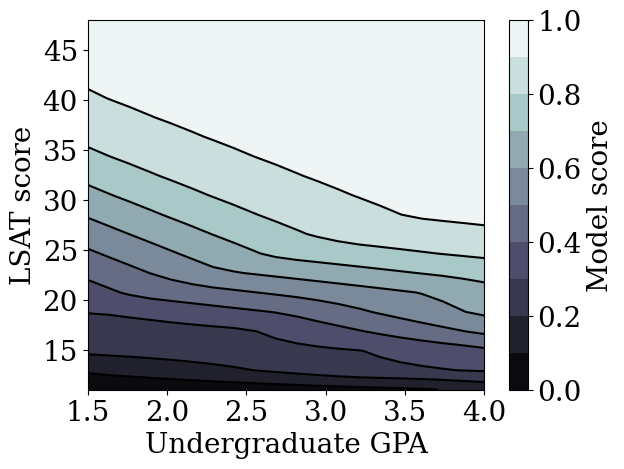
Train an unconstrained Gradient Boosted Trees (GBT) model
The tree structure was previously optimized to achieve high validation accuracy.
tree_model = tfdf.keras.GradientBoostedTreesModel(
exclude_non_specified_features=False,
num_threads=1,
num_trees=20,
max_depth=4,
growing_strategy='BEST_FIRST_GLOBAL',
random_seed=42,
temp_directory=tempfile.mkdtemp(),
)
tree_model.compile(metrics=[keras.metrics.BinaryAccuracy(name='accuracy')])
tree_model.fit(
datasets['law_train'], validation_data=datasets['law_val'], verbose=0
)
tree_train_acc = tree_model.evaluate(datasets['law_train'], verbose=0)[1]
tree_val_acc = tree_model.evaluate(datasets['law_val'], verbose=0)[1]
tree_test_acc = tree_model.evaluate(datasets['law_test'], verbose=0)[1]
print(
'accuracies for GBT: train: %f, val: %f, test: %f'
% (tree_train_acc, tree_val_acc, tree_test_acc)
)
2024-12-15 12:26:19.178391: W external/ydf/yggdrasil_decision_forests/learner/gradient_boosted_trees/gradient_boosted_trees.cc:1840] "goss_alpha" set but "sampling_method" not equal to "GOSS".
2024-12-15 12:26:19.178430: W external/ydf/yggdrasil_decision_forests/learner/gradient_boosted_trees/gradient_boosted_trees.cc:1850] "goss_beta" set but "sampling_method" not equal to "GOSS".
2024-12-15 12:26:19.178438: W external/ydf/yggdrasil_decision_forests/learner/gradient_boosted_trees/gradient_boosted_trees.cc:1864] "selective_gradient_boosting_ratio" set but "sampling_method" not equal to "SELGB".
Num validation examples: tf.Tensor(2328, shape=(), dtype=int32)
WARNING: All log messages before absl::InitializeLog() is called are written to STDERR
I0000 00:00:1734265583.475952 73126 kernel.cc:782] Start Yggdrasil model training
I0000 00:00:1734265583.475995 73126 kernel.cc:783] Collect training examples
I0000 00:00:1734265583.476008 73126 kernel.cc:795] Dataspec guide:
column_guides {
column_name_pattern: "^__LABEL$"
type: CATEGORICAL
categorial {
min_vocab_frequency: 0
max_vocab_count: -1
}
}
default_column_guide {
categorial {
max_vocab_count: 2000
}
discretized_numerical {
maximum_num_bins: 255
}
}
ignore_columns_without_guides: false
detect_numerical_as_discretized_numerical: false
I0000 00:00:1734265583.476352 73126 kernel.cc:401] Number of batches: 63
I0000 00:00:1734265583.476369 73126 kernel.cc:402] Number of examples: 15980
I0000 00:00:1734265583.476750 73126 kernel.cc:802] Training dataset:
Number of records: 15980
Number of columns: 3
Number of columns by type:
NUMERICAL: 2 (66.6667%)
CATEGORICAL: 1 (33.3333%)
Columns:
NUMERICAL: 2 (66.6667%)
0: "0" NUMERICAL mean:3.22705 min:1.6 max:4 sd:0.415473
1: "1" NUMERICAL mean:36.8057 min:11 max:48 sd:5.46358
CATEGORICAL: 1 (33.3333%)
2: "__LABEL" CATEGORICAL integerized vocab-size:3 no-ood-item
Terminology:
nas: Number of non-available (i.e. missing) values.
ood: Out of dictionary.
manually-defined: Attribute whose type is manually defined by the user, i.e., the type was not automatically inferred.
tokenized: The attribute value is obtained through tokenization.
has-dict: The attribute is attached to a string dictionary e.g. a categorical attribute stored as a string.
vocab-size: Number of unique values.
I0000 00:00:1734265583.476770 73126 kernel.cc:807] Collect validation dataset
I0000 00:00:1734265583.476785 73126 kernel.cc:401] Number of batches: 10
I0000 00:00:1734265583.476788 73126 kernel.cc:402] Number of examples: 2328
I0000 00:00:1734265583.476856 73126 kernel.cc:813] Validation dataset:
Number of records: 2328
Number of columns: 3
Number of columns by type:
NUMERICAL: 2 (66.6667%)
CATEGORICAL: 1 (33.3333%)
Columns:
NUMERICAL: 2 (66.6667%)
0: "0" NUMERICAL mean:3.23239 min:1.8 max:4 sd:0.403059
1: "1" NUMERICAL mean:36.8697 min:17 max:48 sd:5.51876
CATEGORICAL: 1 (33.3333%)
2: "__LABEL" CATEGORICAL integerized vocab-size:3 no-ood-item
Terminology:
nas: Number of non-available (i.e. missing) values.
ood: Out of dictionary.
manually-defined: Attribute whose type is manually defined by the user, i.e., the type was not automatically inferred.
tokenized: The attribute value is obtained through tokenization.
has-dict: The attribute is attached to a string dictionary e.g. a categorical attribute stored as a string.
vocab-size: Number of unique values.
I0000 00:00:1734265583.476869 73126 kernel.cc:818] Configure learner
2024-12-15 12:26:23.477070: W external/ydf/yggdrasil_decision_forests/learner/gradient_boosted_trees/gradient_boosted_trees.cc:1840] "goss_alpha" set but "sampling_method" not equal to "GOSS".
2024-12-15 12:26:23.477099: W external/ydf/yggdrasil_decision_forests/learner/gradient_boosted_trees/gradient_boosted_trees.cc:1850] "goss_beta" set but "sampling_method" not equal to "GOSS".
2024-12-15 12:26:23.477106: W external/ydf/yggdrasil_decision_forests/learner/gradient_boosted_trees/gradient_boosted_trees.cc:1864] "selective_gradient_boosting_ratio" set but "sampling_method" not equal to "SELGB".
I0000 00:00:1734265583.477151 73126 kernel.cc:831] Training config:
learner: "GRADIENT_BOOSTED_TREES"
features: "^0$"
features: "^1$"
label: "^__LABEL$"
task: CLASSIFICATION
random_seed: 42
metadata {
framework: "TF Keras"
}
pure_serving_model: false
[yggdrasil_decision_forests.model.gradient_boosted_trees.proto.gradient_boosted_trees_config] {
num_trees: 20
decision_tree {
max_depth: 4
min_examples: 5
in_split_min_examples_check: true
keep_non_leaf_label_distribution: true
num_candidate_attributes: -1
missing_value_policy: GLOBAL_IMPUTATION
allow_na_conditions: false
categorical_set_greedy_forward {
sampling: 0.1
max_num_items: -1
min_item_frequency: 1
}
growing_strategy_best_first_global {
}
categorical {
cart {
}
}
axis_aligned_split {
}
internal {
sorting_strategy: PRESORTED
}
uplift {
min_examples_in_treatment: 5
split_score: KULLBACK_LEIBLER
}
}
shrinkage: 0.1
loss: DEFAULT
validation_set_ratio: 0.1
validation_interval_in_trees: 1
early_stopping: VALIDATION_LOSS_INCREASE
early_stopping_num_trees_look_ahead: 30
l2_regularization: 0
lambda_loss: 1
mart {
}
adapt_subsample_for_maximum_training_duration: false
l1_regularization: 0
use_hessian_gain: false
l2_regularization_categorical: 1
xe_ndcg {
ndcg_truncation: 5
}
stochastic_gradient_boosting {
ratio: 1
}
apply_link_function: true
compute_permutation_variable_importance: false
early_stopping_initial_iteration: 10
}
I0000 00:00:1734265583.477477 73126 kernel.cc:834] Deployment config:
cache_path: "/tmpfs/tmp/tmpvvq5aqsg/working_cache"
num_threads: 1
try_resume_training: true
I0000 00:00:1734265583.477592 100425 kernel.cc:895] Train model
I0000 00:00:1734265583.549481 100425 kernel.cc:926] Export model in log directory: /tmpfs/tmp/tmpvvq5aqsg with prefix 17de4d5178394a23
I0000 00:00:1734265583.550034 100425 kernel.cc:944] Save model in resources
I0000 00:00:1734265583.551071 73126 abstract_model.cc:914] Model self evaluation:
Task: CLASSIFICATION
Label: __LABEL
Loss (BINOMIAL_LOG_LIKELIHOOD): 0.372453
Accuracy: 0.948024 CI95[W][0 1]
ErrorRate: : 0.051976
Confusion Table:
truth\prediction
1 2
1 4 121
2 0 2203
Total: 2328
WARNING: All log messages before absl::InitializeLog() is called are written to STDERR
I0000 00:00:1734265583.561323 73126 quick_scorer_extended.cc:922] The binary was compiled without AVX2 support, but your CPU supports it. Enable it for faster model inference.
I0000 00:00:1734265583.561425 73126 abstract_model.cc:1404] Engine "GradientBoostedTreesQuickScorerExtended" built
accuracies for GBT: train: 0.949625, val: 0.948024, test: 0.951559
plot_model_contour(tree_model)
13/13 [==============================] - 0s 1ms/step
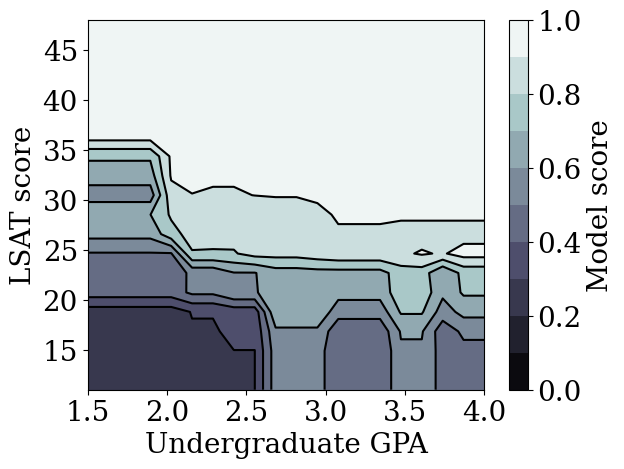
Case study #2: Credit Default
The second case study that we will consider in this tutorial is predicting an individual's credit default probability. We will use the Default of Credit Card Clients dataset from the UCI repository. This data was collected from 30,000 Taiwanese credit card users and contains a binary label of whether or not a user defaulted on a payment in a time window. Features include marital status, gender, education, and how long a user is behind on payment of their existing bills, for each of the months of April-September 2005.
As we did with the first case study, we again illustrate using monotonicity constraints to avoid unfair penalization: if the model were to be used to determine a user’s credit score, it could feel unfair to many if they were penalized for paying their bills sooner, all else equal. Thus, we apply a monotonicity constraint that keeps the model from penalizing early payments.
Load Credit Default data
# Load data file.
credit_file_name = 'credit_default.csv'
credit_file_path = os.path.join(DATA_DIR, credit_file_name)
credit_df = pd.read_csv(credit_file_path, delimiter=',')
# Define label column name.
CREDIT_LABEL = 'default'
Split data into train/validation/test sets
dfs = {}
datasets = {}
dfs["credit_train"], dfs["credit_val"], dfs["credit_test"] = split_dataset(
credit_df
)
for df_name, df in dfs.items():
datasets[df_name] = tf.data.Dataset.from_tensor_slices(
((df[['MARRIAGE']], df[['PAY_0']]), df[['default']])
).batch(BATCH_SIZE)
Visualize data distribution
First we will visualize the distribution of the data. We will plot the mean and standard error of the observed default rate for people with different marital statuses and repayment statuses. The repayment status represents the number of months a person is behind on paying back their loan (as of April 2005).
def get_agg_data(df, x_col, y_col, bins=11):
xbins = pd.cut(df[x_col], bins=bins)
data = df[[x_col, y_col]].groupby(xbins).agg(['mean', 'sem'])
return data
def plot_2d_means_credit(input_df, x_col, y_col, x_label, y_label):
plt.rcParams['font.family'] = ['serif']
_, ax = plt.subplots(nrows=1, ncols=1)
plt.setp(ax.spines.values(), color='black', linewidth=1)
ax.tick_params(
direction='in', length=6, width=1, top=False, right=False, labelsize=18)
df_single = get_agg_data(input_df[input_df['MARRIAGE'] == 1], x_col, y_col)
df_married = get_agg_data(input_df[input_df['MARRIAGE'] == 2], x_col, y_col)
ax.errorbar(
df_single[(x_col, 'mean')],
df_single[(y_col, 'mean')],
xerr=df_single[(x_col, 'sem')],
yerr=df_single[(y_col, 'sem')],
color='orange',
marker='s',
capsize=3,
capthick=1,
label='Single',
markersize=10,
linestyle='')
ax.errorbar(
df_married[(x_col, 'mean')],
df_married[(y_col, 'mean')],
xerr=df_married[(x_col, 'sem')],
yerr=df_married[(y_col, 'sem')],
color='b',
marker='^',
capsize=3,
capthick=1,
label='Married',
markersize=10,
linestyle='')
leg = ax.legend(loc='upper left', fontsize=18, frameon=True, numpoints=1)
ax.set_xlabel(x_label, fontsize=18)
ax.set_ylabel(y_label, fontsize=18)
ax.set_ylim(0, 1.1)
ax.set_xlim(-2, 8.5)
ax.patch.set_facecolor('white')
leg.get_frame().set_edgecolor('black')
leg.get_frame().set_facecolor('white')
leg.get_frame().set_linewidth(1)
plt.show()
plot_2d_means_credit(
dfs['credit_train'],
'PAY_0',
'default',
'Repayment Status (April)',
'Observed default rate',
)
/tmpfs/tmp/ipykernel_73126/4037607942.py:3: FutureWarning: The default of observed=False is deprecated and will be changed to True in a future version of pandas. Pass observed=False to retain current behavior or observed=True to adopt the future default and silence this warning. data = df[[x_col, y_col]].groupby(xbins).agg(['mean', 'sem']) /tmpfs/tmp/ipykernel_73126/4037607942.py:3: FutureWarning: The default of observed=False is deprecated and will be changed to True in a future version of pandas. Pass observed=False to retain current behavior or observed=True to adopt the future default and silence this warning. data = df[[x_col, y_col]].groupby(xbins).agg(['mean', 'sem'])

Train calibrated lattice model to predict credit default rate
Next, we will train a calibrated lattice model from TFL to predict whether or not a person will default on a loan. The two input features will be the person's marital status and how many months the person is behind on paying back their loans in April (repayment status). The training label will be whether or not the person defaulted on a loan.
We will first train a calibrated lattice model without any constraints. Then, we will train a calibrated lattice model with monotonicity constraints and observe the difference in the model output and accuracy.
Helper functions for visualization of trained model outputs
def plot_predictions_credit(
input_df,
model,
x_col,
x_label='Repayment Status (April)',
y_label='Predicted default probability',
):
predictions = model.predict((input_df[['MARRIAGE']], input_df[['PAY_0']]))
predictions = tf.math.sigmoid(predictions)
new_df = input_df.copy()
new_df.loc[:, 'predictions'] = predictions
plot_2d_means_credit(new_df, x_col, 'predictions', x_label, y_label)
Train unconstrained (non-monotonic) calibrated lattice model
model_config = tfl.configs.CalibratedLatticeConfig(
feature_configs=[
tfl.configs.FeatureConfig(
name='MARRIAGE',
lattice_size=3,
pwl_calibration_num_keypoints=2,
monotonicity=0,
pwl_calibration_always_monotonic=False,
),
tfl.configs.FeatureConfig(
name='PAY_0',
lattice_size=3,
pwl_calibration_num_keypoints=16,
monotonicity=0,
pwl_calibration_always_monotonic=False,
),
],
output_calibration=True,
output_initialization=np.linspace(-2, 2, num=8),
)
feature_keypoints = tfl.premade_lib.compute_feature_keypoints(
feature_configs=model_config.feature_configs,
features=dfs["credit_train"][['MARRIAGE', 'PAY_0', 'default']],
)
tfl.premade_lib.set_feature_keypoints(
feature_configs=model_config.feature_configs,
feature_keypoints=feature_keypoints,
add_missing_feature_configs=False,
)
nomon_lattice_model = tfl.premade.CalibratedLattice(model_config=model_config)
nomon_lattice_model.compile(
loss=keras.losses.BinaryCrossentropy(from_logits=True),
metrics=[
keras.metrics.BinaryAccuracy(name='accuracy'),
],
optimizer=keras.optimizers.Adam(LEARNING_RATES),
)
nomon_lattice_model.fit(datasets['credit_train'], epochs=NUM_EPOCHS, verbose=0)
train_acc = nomon_lattice_model.evaluate(datasets['credit_train'])[1]
val_acc = nomon_lattice_model.evaluate(datasets['credit_val'])[1]
test_acc = nomon_lattice_model.evaluate(datasets['credit_test'])[1]
print(
'accuracies for train: %f, val: %f, test: %f'
% (train_acc, val_acc, test_acc)
)
83/83 [==============================] - 0s 1ms/step - loss: 0.4537 - accuracy: 0.8186 12/12 [==============================] - 0s 1ms/step - loss: 0.4423 - accuracy: 0.8291 24/24 [==============================] - 0s 1ms/step - loss: 0.4547 - accuracy: 0.8168 accuracies for train: 0.818619, val: 0.829085, test: 0.816835
plot_predictions_credit(dfs['credit_train'], nomon_lattice_model, 'PAY_0')
657/657 [==============================] - 1s 1ms/step /tmpfs/tmp/ipykernel_73126/4037607942.py:3: FutureWarning: The default of observed=False is deprecated and will be changed to True in a future version of pandas. Pass observed=False to retain current behavior or observed=True to adopt the future default and silence this warning. data = df[[x_col, y_col]].groupby(xbins).agg(['mean', 'sem']) /tmpfs/tmp/ipykernel_73126/4037607942.py:3: FutureWarning: The default of observed=False is deprecated and will be changed to True in a future version of pandas. Pass observed=False to retain current behavior or observed=True to adopt the future default and silence this warning. data = df[[x_col, y_col]].groupby(xbins).agg(['mean', 'sem'])
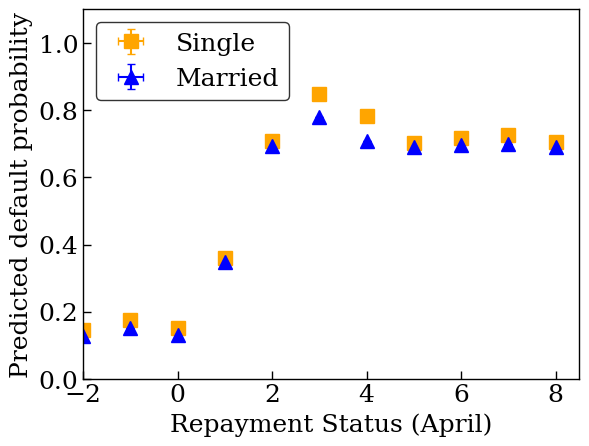
Train monotonic calibrated lattice model
model_config.feature_configs[0].monotonicity = 1
model_config.feature_configs[1].monotonicity = 1
mon_lattice_model = tfl.premade.CalibratedLattice(model_config=model_config)
mon_lattice_model.compile(
loss=keras.losses.BinaryCrossentropy(from_logits=True),
metrics=[
keras.metrics.BinaryAccuracy(name='accuracy'),
],
optimizer=keras.optimizers.Adam(LEARNING_RATES),
)
mon_lattice_model.fit(datasets['credit_train'], epochs=NUM_EPOCHS, verbose=0)
train_acc = mon_lattice_model.evaluate(datasets['credit_train'])[1]
val_acc = mon_lattice_model.evaluate(datasets['credit_val'])[1]
test_acc = mon_lattice_model.evaluate(datasets['credit_test'])[1]
print(
'accuracies for train: %f, val: %f, test: %f'
% (train_acc, val_acc, test_acc)
)
83/83 [==============================] - 0s 1ms/step - loss: 0.4548 - accuracy: 0.8188 12/12 [==============================] - 0s 1ms/step - loss: 0.4426 - accuracy: 0.8301 24/24 [==============================] - 0s 1ms/step - loss: 0.4551 - accuracy: 0.8172 accuracies for train: 0.818762, val: 0.830065, test: 0.817172
plot_predictions_credit(dfs['credit_train'], mon_lattice_model, 'PAY_0')
657/657 [==============================] - 1s 1ms/step /tmpfs/tmp/ipykernel_73126/4037607942.py:3: FutureWarning: The default of observed=False is deprecated and will be changed to True in a future version of pandas. Pass observed=False to retain current behavior or observed=True to adopt the future default and silence this warning. data = df[[x_col, y_col]].groupby(xbins).agg(['mean', 'sem']) /tmpfs/tmp/ipykernel_73126/4037607942.py:3: FutureWarning: The default of observed=False is deprecated and will be changed to True in a future version of pandas. Pass observed=False to retain current behavior or observed=True to adopt the future default and silence this warning. data = df[[x_col, y_col]].groupby(xbins).agg(['mean', 'sem'])
